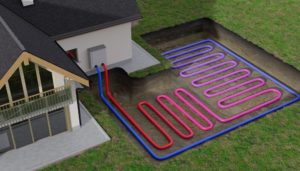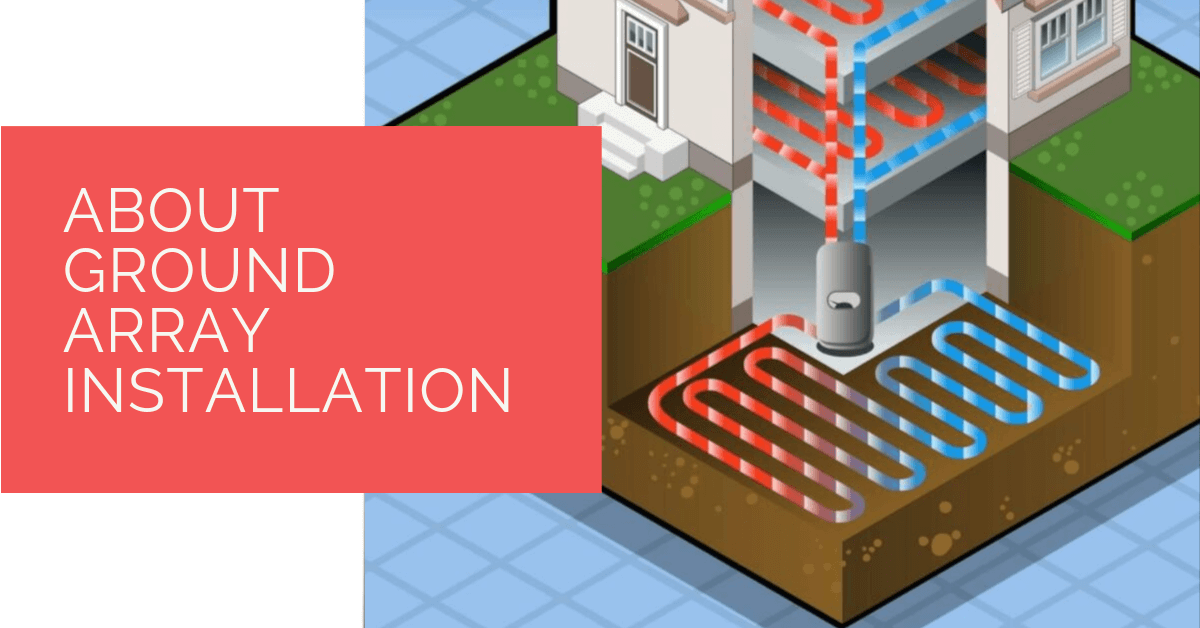The ground array system is one of the most important aspects of ground source heat pump installation. It is crucial that the ground array system is sized and installed correctly. They are typically the most expensive element to install when installing ground source heat pumps. In the UK, the ground array system is either a horizontal array that uses straight pipes in trenches or a vertical array that uses U-tubes inserted into boreholes.
The design and installation of the ground array system are crucial to the success of the operation of the ground source heat pump. In fact, the ground array supplies the required energy to heat the building. You may invest in the latest ground source heat pump on the market, but if the ground array system isn’t installed properly, you won’t get any heat. This article provides information on the effective ground array installation.
Ground source heat pumps use renewable energy from the ground in order to provide a low-cost as well as a low-carbon form of heat to heat your buildings. The heat pump would absorb energy from the ground via ground arrays or buried heat exchange devices. The temperature of the ground is almost constant all year round. In fact, the ground temperature is at around 8-12C throughout the year. It’s a great energy source for ground heat pumps. The ground will absorb solar energy by means of sunlight and rain. The energy isn’t infinite because the ground acts like a battery that needs to be recharged by the sun and rain. That’s why incorrectly sized and designed ground array systems lead to much lower outputs from ground source heat pumps. That’s why a water antifreeze is usually circulated around the ground array system to transfer the energy from the ground to the heat pump. Ground array systems come in a wide variety of designs and types.
Contents
Key Takeaways:
- The ground array system is a crucial component of ground source heat pump installation and significantly impacts its efficiency and effectiveness.
- There are various types of ground array systems, including slinky pipes, straight pipes, boreholes, and water systems, each with advantages and cost considerations.
- The sizing of ground array systems varies based on the type, with slinkies requiring approximately 10 meters of trench per 1 kW of heat, boreholes offering higher energy yield per meter, and water sources providing around 7 kW per pond mat.
Types Of Ground Arrays
Slinky Pipes
Slinkies significantly reduce the amount of digging involved when installing ground arrays. Hence, they are one of the most cost-effective types of ground arrays. Slinky pipes were developed by the University Of Oklahoma. They are some of the best heat sources for heat pumps in the United Kingdom today. A slinky pipe is a length of plastic coiled pipe buried in the ground with the use of a digger. They are installed horizontally or vertically. Due to the efficiency and low-cost, slinky pipe ground arrays are some of the most recommended in the United Kingdom.
Straight Pipes
Straight pipe ground array systems are also popular in the United Kingdom. But this system will increase the amount of digging by up to 5 times when compared to slinky pipes. The cost of installation is much higher than slinky pipes. In fact, slinky pipes and straight pipes have the same level of performance. Heat pumps can operate with both these ground array installation systems. But due to the lower cost, slinky pipes are recommended for a ground source heat pump.
Boreholes
Boreholes are the alternative to both slinkies and straight pipes. When there isn’t enough space to install slinkies and straight pipes on the ground, boreholes are the solution. Boreholes are installed by digging vertically down. They tend to be 60-100m deep and consist of a single looped pipe within the borehole. The borehole is normally filled with thermal grout. The number of boreholes required and their depth will depend on the condition of the ground where the digging is done. Borehole installation should be done by a professional installer. Hence, it is considered an expensive alternative.
Water Systems
If your property is located near a lake, lake water can be used as an energy source. The digging is kept to a minimum when installing this system. Hence, it is cost-effective and viable compared to most of the other systems. Water systems can be open source or closed source. The closed-loop system is the most popular in this regard.

Sizing Of Ground Array Systems
Slinky Array
The amount of sunlight that lands on the ground (per square metre) is almost similar anywhere in the United Kingdom. The amount of energy available for heat absorption doesn’t depend on the soil type. In fact, wet soil is ideal compared to well-drained soil in this regard. The sizing of slinkies doesn’t consider the soil type. The moisture content of the soil can affect heat transfer rates. The formula is to use 10 metres of trench to provide 1 kW of heat from the heat pump.
Boreholes Array
Boreholes arrays offer a higher energy yield per metre of array compared to other systems. A borehole can provide between 30W/m and 50W/m of energy to operate the heat pump.
Water Source Array
Water is an ideal source of energy for heat pumps. It has a higher conductivity compared to other systems. The energy extraction rate is usually about 7kW per pond mat.
Case Study: Efficient Ground Array Installation for a Residential Property
Background
At Heat Pump Source, we often encounter homeowners interested in upgrading their heating systems to more sustainable and cost-effective solutions. One recent project involved installing a ground source heat pump system for a residential property. The homeowner wanted an eco-friendly solution that would provide consistent heating while reducing energy bills.
Project Overview
The client’s property was situated in a suburban area with ample land, making it suitable for various types of ground array installations. After an initial assessment, we determined that a slinky pipe ground array would be the most cost-effective and efficient choice, given the property’s soil type and available space.
Implementation
- Assessment and Planning: Site analysis was conducted to understand soil conditions, space availability, and potential heat extraction rates. A slinky pipe ground array system was recommended for its efficiency and lower installation costs.
- Excavation: The necessary trenches were dug, ensuring adequate depth and spacing for optimal ground heat absorption.
- Array Installation: Slinky pipes were installed in the trenches with proper spacing and secure placement for maximum efficiency and durability.
- System Integration: The ground array was connected to the heat pump system, ensuring all connections were secure and the system was calibrated correctly.
- Quality Assurance and Testing: System tests were conducted to check flow rates, temperature differentials, and overall system performance. Detailed instructions were provided to the homeowner on system operation and maintenance.
Results
- Enhanced Efficiency: The ground source heat pump system provided consistent heating, with a Coefficient of Performance (COP) of 4.0, indicating high efficiency.
- Cost Savings: The homeowner experienced a significant reduction in energy bills, with estimated savings of around 30% compared to the previous gas heating system. The efficient slinky pipe design reduced both operational costs and maintenance needs.
- Environmental Impact: The switch to a ground source heat pump system significantly reduced the property’s carbon footprint. The system’s reliance on ground energy decreased the use of fossil fuels, aligning with the homeowner’s environmental goals.
Summary
The installation of a ground source heat pump system with a slinky pipe ground array was a successful and cost-effective solution for the homeowner. At Heat Pump Source, we pride ourselves on delivering tailored heating solutions that meet the specific needs of our clients. This project highlighted the importance of precise planning and professional installation in achieving optimal system performance. With the new system in place, the homeowner now enjoys reliable, efficient, and environmentally friendly heating, showcasing the benefits of modern ground source heat pump technology.
Expert Insights About Ground Array Installation
The efficiency of a ground source heat pump largely hinges on the design and installation of its ground array system. A well-sized and correctly installed array ensures optimal energy extraction and system longevity.
Lead Engineer
Choosing the right type of ground array—be it slinky pipes, straight pipes, or boreholes—depends on the site’s specific conditions and space availability. Our team meticulously assesses these factors to recommend the most suitable and cost-effective solution.
Senior Installation Specialist
Proper installation and sizing of ground arrays are crucial. A miscalculation can lead to reduced efficiency and higher operational costs, which is why our experienced professionals handle each project with the utmost precision and care.
Project Manager
Heat Pump Source: Reliable Heating and Cooling Solutions
At Heat Pump Source, we take pride in our unwavering commitment to serving the UK with top-tier HVAC solutions. From the efficiency of heat pumps and the cool relief of air conditioning to the warmth of boilers, radiators, and underfloor heating, our dedicated team is always at the forefront of innovation. We understand the unique needs of every household and business, and we strive to provide dependable health and cooling products and services that are tailored just for you. Ensuring your comfort and satisfaction is our utmost priority. Whether you have questions, need guidance, or require support, we’re always here to assist. Please don’t hesitate to contact us; we’re eager to be of service.
Conclusion
Properly designing and installing a ground array system is pivotal to successfully operating ground source heat pumps. Choosing the right ground array type and sizing it correctly can significantly impact energy efficiency and cost-effectiveness. Whether opting for slinky pipes, straight pipes, boreholes, or water systems, understanding their advantages and considering the unique characteristics of each system is essential. By making informed choices in ground array installation, you can effectively harness renewable energy from the ground and enjoy the benefits of a low-cost, low-carbon heating solution for your buildings.
About the Author
At Heat Pump Source, our articles are the product of a collaborative effort among a team of highly skilled HVAC experts. Our dedicated professionals, hailing from diverse backgrounds in heating, ventilation, air conditioning, and refrigeration, contribute their extensive knowledge and experience to every piece of content. This multidisciplinary approach ensures comprehensive coverage. Our commitment is to deliver authoritative, reliable, and tailored advice to meet the unique needs of every household and business across the UK.

